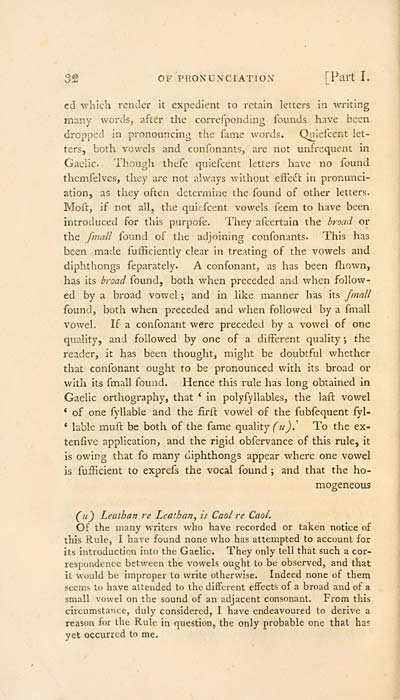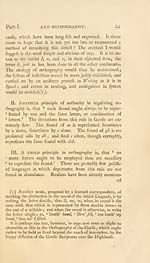Download files
Complete book:
Individual page:
Thumbnail gallery: Grid view | List view

32 OF PROiVuxciATiON' [Part I.
cd which render It expedient to retain letters in writing
many words, after the correfponding founds have been
dropped in pronouncing the fame words. Quiefcent let-
ters, both vowels and confonants, are not unfrequent in
Gaelic. Though thefe quiefcent letters have no found
themfelves, they are not always without efteiSt in pronunci-
ation, as they often determine the found of other letters.
Moft, if not all, the quiefcent vowels feem to have been
introduced for this purpofe. They afcertain the broad or
the /mall found of the adjoining confonants. This has
been made fufficiently clear in treating of the vowels and
diphthongs feparately. A confonant, as has been fliown,
has its broad found, both when preceded and when follow-
ed by a broad vowel ; and in like manner has its /mall
found, both when preceded and when followed by a fmall
vowel. If a confonant were preceded by a vowel of one
quality, and followed by one of a different quality ; the
reader, it has been thought, might be doubtful whether
that confonant ought to be pronounced with its broad or
with its fmall fouiid. Hence this rule has long obtained in
Gaelic orthography, that * in polyfyllables, the laft vov/el
* of one fyllable and the firft vowel of the fubfequent fyl-
* lable mull: be both of the fame quality (u).' To the ex-
tenfive application, and the rigid obfervance of this rule, it
is owing that fo many diphthongs appear where one vowel
is fuiHcient to exprefs the vocal found ; and that the ho-
mogeneous
(u^ Leathan re Leathan^ is Caol re CaoL
Of the many writers who have recorded or taken notice of
this Rule, I have found none who has attempted to account for
its introduction into the Gaelic. They only tell that such a cor-
respondence between the vowels ought to be observed, and that
it would be improper to write otherwise. Indeed none of them
seems to have attended to the different effects of a broad and of a
small vowel on the sound of an adjacent consonant. From this
circumstance, duly considered, I have endeavoured to derive a
reason for the Rule in question, the only probable one that ha?
yet occurred to me.
cd which render It expedient to retain letters in writing
many words, after the correfponding founds have been
dropped in pronouncing the fame words. Quiefcent let-
ters, both vowels and confonants, are not unfrequent in
Gaelic. Though thefe quiefcent letters have no found
themfelves, they are not always without efteiSt in pronunci-
ation, as they often determine the found of other letters.
Moft, if not all, the quiefcent vowels feem to have been
introduced for this purpofe. They afcertain the broad or
the /mall found of the adjoining confonants. This has
been made fufficiently clear in treating of the vowels and
diphthongs feparately. A confonant, as has been fliown,
has its broad found, both when preceded and when follow-
ed by a broad vowel ; and in like manner has its /mall
found, both when preceded and when followed by a fmall
vowel. If a confonant were preceded by a vowel of one
quality, and followed by one of a different quality ; the
reader, it has been thought, might be doubtful whether
that confonant ought to be pronounced with its broad or
with its fmall fouiid. Hence this rule has long obtained in
Gaelic orthography, that * in polyfyllables, the laft vov/el
* of one fyllable and the firft vowel of the fubfequent fyl-
* lable mull: be both of the fame quality (u).' To the ex-
tenfive application, and the rigid obfervance of this rule, it
is owing that fo many diphthongs appear where one vowel
is fuiHcient to exprefs the vocal found ; and that the ho-
mogeneous
(u^ Leathan re Leathan^ is Caol re CaoL
Of the many writers who have recorded or taken notice of
this Rule, I have found none who has attempted to account for
its introduction into the Gaelic. They only tell that such a cor-
respondence between the vowels ought to be observed, and that
it would be improper to write otherwise. Indeed none of them
seems to have attended to the different effects of a broad and of a
small vowel on the sound of an adjacent consonant. From this
circumstance, duly considered, I have endeavoured to derive a
reason for the Rule in question, the only probable one that ha?
yet occurred to me.
Set display mode to: Large image | Transcription
Images and transcriptions on this page, including medium image downloads, may be used under the Creative Commons Attribution 4.0 International Licence unless otherwise stated. ![]()
| Early Gaelic Book Collections > Blair Collection > Elements of Gaelic grammar > (62) |
|---|
| Permanent URL | https://digital.nls.uk/79040719 |
|---|
| Description | A selection of books from a collection of more than 500 titles, mostly on religious and literary topics. Also includes some material dealing with other Celtic languages and societies. Collection created towards the end of the 19th century by Lady Evelyn Stewart Murray. |
|---|
| Description | Selected items from five 'Special and Named Printed Collections'. Includes books in Gaelic and other Celtic languages, works about the Gaels, their languages, literature, culture and history. |
|---|

